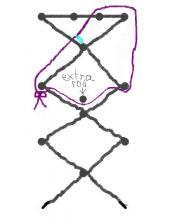Hello all.I am a newbie... weaved 1 bathmat and a headband with worsted weight cotton.My loom is a clothes drying rack :-).

It is made of metal.The rods, in relation to each other, are like the inkle loom so I use heddle strings on the appropriate rod. Every dot represents a rod.I removed the lowest front rod and replaced the screws that held it on with a longer screw & a wing nut.I ran a string through that rod and suspended it from the rod above it.Then I used velcro to hold that rod down to the rod below it... insuring the rod is level. When I need to release tension I make the velcro longer.The heddle string loops are tied around a 15 ml bottle and I leave the tails and tie them on the heddle rod.When I tie them on I use a spacer (a thin metal rod from a pants hanger) so that they can be moved.Every warp is knotted in the front.I wrap the middle one first & then the 2 ends (selvedge warps) to stabilize the rod.Then I warp the rest... threading the heddled ones through the heddle loops.I have to keep the tension loose or the rods bend.The rack folds when not in use.Yay.I'm particularly interested in doing a Celtic Knot weave or some kind of curves or overlapping curves. Loom weaving drafts don't apply to my loom and neither do frame loom drafts. Inkle loom drafts are more like it except I can weave 24" wide and can't wrap my brain around enlarging a pattern... or how to somehow figure out how to apply other loom patterns to my loom.On rigidheddleweaving I saw that it is possible to use 4 string heddle sticks that sit on top of the weaving until you need to pull it up to create a shed.That is probably how I would accomplish a Twill or Celtic Knot... I think.Any guidance on accomplishing a curving pattern for my loom is appreciated.I have dial-up and a 22 year old computer so I don't have too many online options. Just retrieving e-mails is difficult. So was signing up here.I am soooo done with hours of internet searches and not finding anything useful on patterns.
